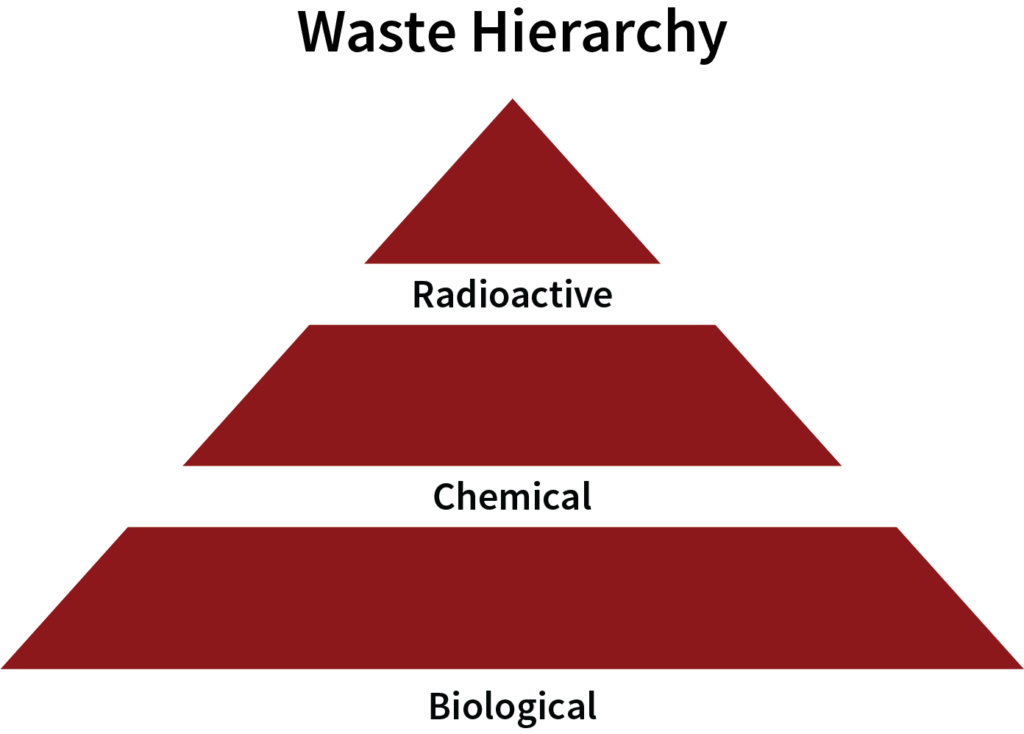Once you have determined that you’ve generated waste, consult the Radiological-Chemical-Biological Waste chart in the Waste Hierarchy tab below. Use the Non-Hazardous Chemical Waste List and the Empty Container Decision Tree to determine whether or not the waste is hazardous.
Remember that a material is not waste until it has no intended use. Surplus chemicals are notwastes.
All chemical wastes from laboratories are presumed to be regulated hazardous wastes, unless EH&S has demonstrated that they are both non-hazardous and appropriate for drain or trash disposal.
EH&S maintains a list of specific chemical wastes that are not regulated hazardous wastes.
If your waste is on the list, you may dispose of it as directed. If it is not on the list, but you believe it may be non-hazardous, EH&S can perform a waste determination (a literature search, potentially followed by chemical analysis) to see if drain or trash disposal is appropriate. For a waste determination, contact EH&S at (650) 723-5069 or cesare@stanford.edu.
Once you have determined that you’ve generated waste, use the Radiological-Chemical-Biological Waste Hierarchy below to identify the regulations governing proper waste management.

Mixed waste contains radiological or biological waste in addition to chemical waste. It must be handled properly. According to the hierarchy of mixed waste, radiological properties, when present, are the most important factors used to determine proper waste handling, followed by chemical properties, then biological properties. Many “buffers” contain hazardous materials, and many processes using hazardous chemicals as “wash” solutions may result in a mixed waste.
Examples of commonly used hazardous materials that may result in a mixed waste:
- Alcohols (ethanol, methanol, isopropanol)
- Tri-fluoro Acetic Acid (TFA), Acetic Acid
- Sodium Hydroxide
- Chloroform
- Formamide
Some trademarked reagents and “Kits” may contain hazardous materials. Always review the MSDS to determine if any proprietary material you are using contains hazardous materials. Researchers must obtain permission from the Radiation Safety Committee to generate mixed waste. Contact your Health Physicist or (650) 723-3201.
How to Handle Mixed Waste
Follow the steps below to correctly handle your mixed waste. You may also refer to the Mixed Radioactive and Chemical Waste Flowchart for these steps.
The first step is to determine if the hazardous materials are present in sufficient concentration to make your waste a regulated mixed waste. Dilute concentrations of hazardous materials may not meet the regulatory definition. Please review the List of Non-Hazardous Chemical Wastes to determine the correct disposal method. If your waste contains only non-hazardous wastes as noted on the list, you do not have a mixed waste and it may be managed as a normal radioactive waste.
If your waste contains materials not listed on the Non-Hazardous Chemical Waste list, calculations or testing may be necessary to determine if your waste is regulated. For assistance with this, request a Waste Determination.
Mixed Waste Management Procedures
Waste containing P32 (½ life of 15 days)
- Store the mixed waste in your lab for ten ½ lives (150 days)
- During storage, affix a Stanford hazardous waste tag
- Create a tag using our on-line system
- Also label the waste with Isotope and Activity
- If you add additional radioactive waste after initially dating the container, the hold for decay time is extended, but you cannot change the date on the chemical waste tag.
- Once ten ½ lives have elapsed for all wastes in the container, submit a pickup request to EH&S.
- You must submit a pickup request when the container is no more than 8 months old, and you must hold the waste for ten ½ lives. For this reason, you should not add additional wastes to the container after 100 days have passed since the original waste was added.
- To submit a pickup request, go to our on-line WasteTag system
- Please note in the comments section of the request that your waste previously contained radio-isotopes.
Long-Lived Isotopes
If you must use long-lived isotopes such as I125, S35, C14 and H3, determine if the hazardous chemical portion can be treated to make it non-hazardous.
- Common treatment methods are neutralization and solidification in cement. In order to conduct this treatment, you must obtain additional training from EH&S, and keep records.
- Please contact the Environmental Protection Program at (650) 725-7529
Waste that Cannot be Treated
If long-lived mixed waste cannot be treated, you must manage your waste in accordance with both the Chemical Waste and the Radiation Safety requirements including labeling as noted above.
- Due to difficulty of securing disposal options for these wastes, you must submit a pickup request to the Chemical Waste Program within 6 months of generation.
- Again, do not add radioactive waste to the container more than 100 days after the initial waste was generated.
